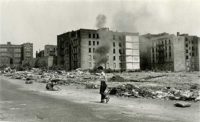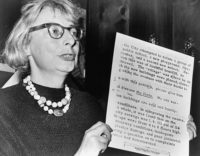The experience of New York can be overwhelming, especially now. Dramatic rent increases are squeezing more and more people out of their communities. Interchangeable glass towers shoot up like weeds. Thin skyscraper-playgrounds of the ultra-rich assault the skyline. The scale and pace of the changing city feels extreme, but it’s a story as old as New York itself.
That pressure on the present, squeezed between the past and future, has been documented for more than five decades by filmmaker Manfred Kirchheimer. He might not be a household name, but Kirchheimer is a keen observer of the urban landscape, and his films reflect a profound understanding of their ephemerality. The Museum of Modern Art is hosting a career-spanning retrospective of his work, running February 3-11, and the timing couldn’t be better.
“I think that every city is in constant flux,” says Joshua Siegel, the film department curator who organized the series. “Nothing ever is truly erased. But things are very quickly built on top of or over, and that process, which is true of any urban setting, can be viewed over the course of the 50 years in which [Kirchheimer] was making films.”
After studying with Dadaist and experimental filmmaker Hans Richter at New York’s City College in the early 1950s, Kirchheimer released his first film, Colossus on the River, in 1965. The 15-minute short is a straightforward chronicle of the docking of a transcontinental ocean liner at a New York port. But what seemed mundane then feels almost monumental today. In the 21st century, air travel has all but replaced ocean voyages, a fact that fundamentally alters how we watch the film. It’s no longer a simple record of a ship arrival; it’s a window into an urban experience that has essentially disappeared.
That kind of cinematic preservation is a hallmark of Kirchheimer’s work—one he insists isn’t intentional. “I never thought of that,” Kirchheimer says. “I thought of these individual subjects. I chose the city because it was there and I didn’t have the money to go out of town.” And yet, his work betrays that modest self-appraisal. Claw, a short from 1968, documents pre-war New York being razed for modernist towers. The feature-length We Are So Beloved, from 1986, captures the voices of German Jews who escaped the Holocaust and created a new community in Washington Heights. Even a more contemporary film, like 2014’s Canners, has a sense of bearing witness. By following 22 people who collect cans and bottles for the five-cent refund, Kirchheimer protects the faces, voices, and experiences of people almost guaranteed to be forgotten as New York bounds toward the future.
And then there’s Kirchheimer’s best-known work, 1981’s Stations of the Elevated. The 45-minute film is less a documentary than a poetic celebration of the city’s maligned graffiti-covered subway cars. Where many chafed at garish symbols of urban blight, Kirchheimer saw something else. Outdoors, watching all 10 cars as a single moving canvas, the graffiti came alive. The experience was “so different from what happened when you were in an indoor platform,” Kirchheimer says. “This train comes in with very in-your-face graffiti. You only see a small portion of it, everybody’s grumbling about it, and it looks dirtier than it is because you’re indoors. But here I was seeing it in a different mode.”
After shooting for about three weeks, he assembled his footage nonlinearly to luxuriate on the art and locate it in a broader urban narrative. It’s contextualized with scenes of Bronx residents living amidst the ruins of gutted and scorched apartment buildings, and placed in argument with socially-accepted hand-painted corporate advertising. Paired with the trains’ clacking and screeching, Charles Mingus tunes and Aretha Franklin’s rendition of “Amazing Grace” form the soundtrack. The result is a powerful document of New York at its bleakest—and most vibrant.
Siegel says he’s drawn to Kirchheimer’s films because they “are very much in tune with how buildings, or just urban landscapes, are experienced—warts and all.” But with the exception of Stations’ revival in 2014, Kirchheimer’s work has been underseen and neglected. “I don’t think he has the kind of recognition that he deserves,” Siegel continues. “I think that when people saw Stations of the Elevated they found it to be a revelation, but there’s a lot more that needs to be discovered.”
The MoMA retrospective helps correct the record. The museum is screening all of his work, as well as those films he collaborated on with Leo Hurwitz. It will open with the premiere of My Coffee With Jewish Friends, a 90-minute series of conversations on the topic, as Kirchheimer puts it, of “Jewishness.”
That sounds like a departure from the rest of Kirchheimer’s oeuvre. But an exploration of cultural identity at this particular moment of social, cultural, and economic upheaval is directly in line with the preservation of the urban experience that scaffolds his other films—even if he balks at the idea.
“I didn’t really think of documenting New York,” Kirchheimer says. “And now that I’m told that I did—I don’t see it, especially. To me the films are all current, and New York life in them is current.”











